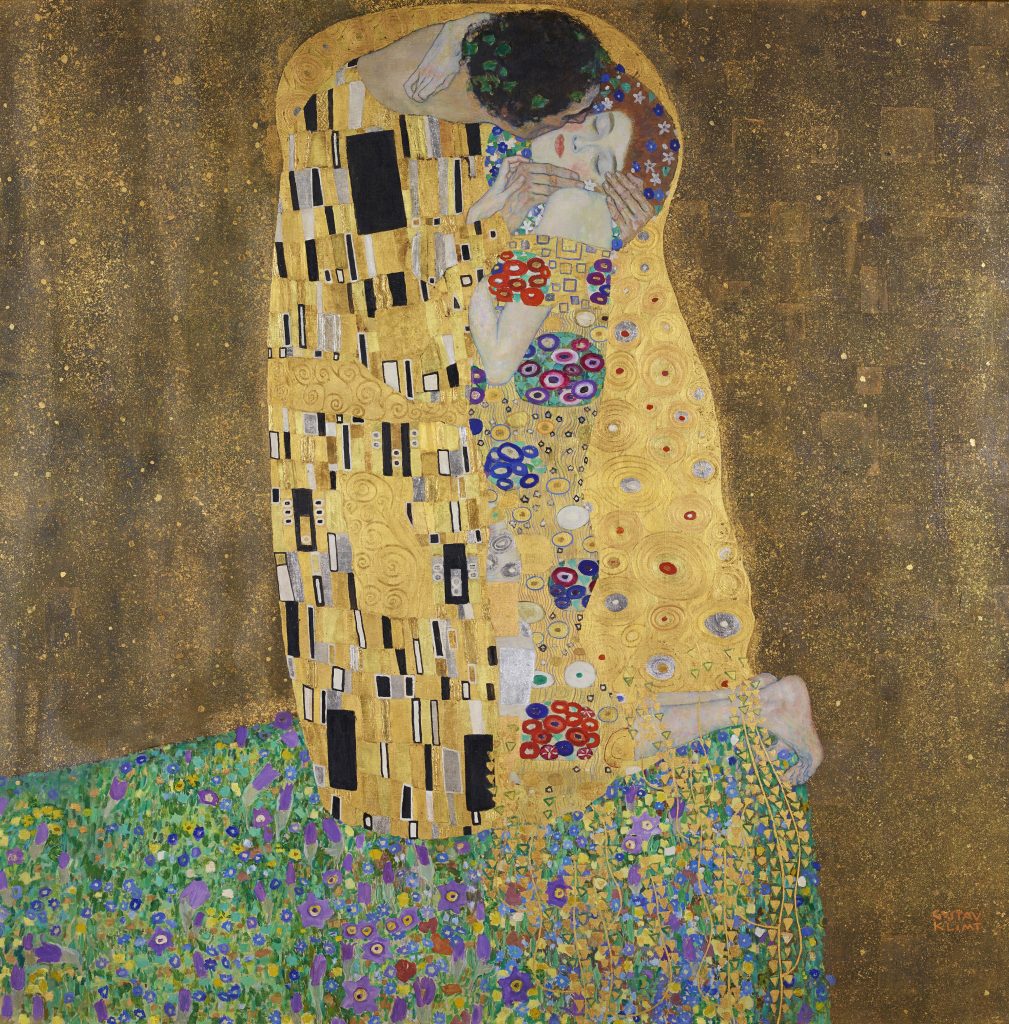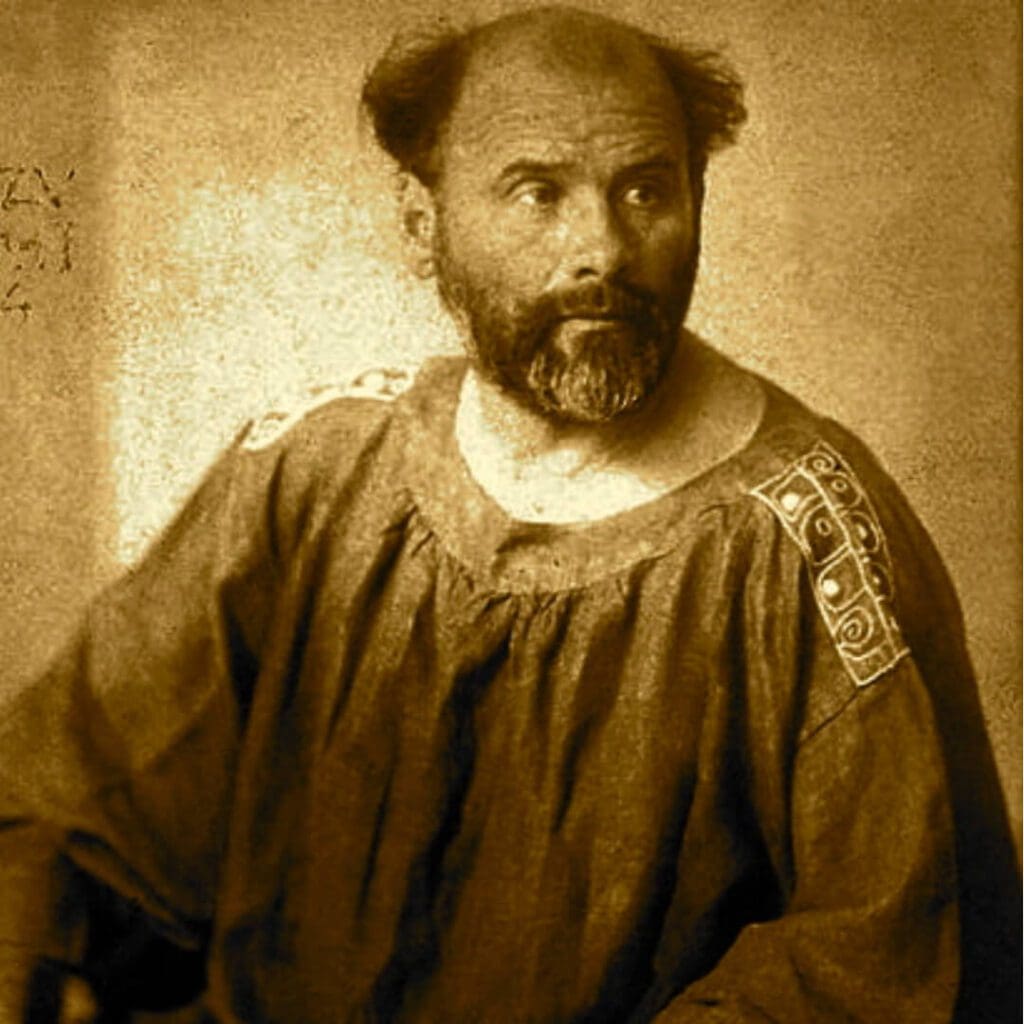Many people know Gustav Klimt as the artist who produced the famous 1907 painting “The Kiss.” The Kiss is the masterpiece of two figures that melt into each other with a hungry embrace. Many artists have been inspired by this artwork and created variations of it.
In his early artistic years, Gustav Klimt was inspired by Han Markart; the Vienna avant-garde society and Japanese Ukiyo-E artists also influenced him. Klimt is known as a founding member of the Vienna artistic group called Secession.
Table of Contents
- Who Inspired Gustav Klimt?
- Klimt and The Secession
- Klimt and Japanese Art
- Frequently Asked Questions
- Related Questions

Who Inspired Gustav Klimt?
Gustav Klimt is unique because several people and events inspired him during his artistic career. No single person or event ever inspired him and his art; he, indeed, was an artist who paved the way for many in the art he created.
Inspired by the Artist Han Makart
Early in his career, Gustav Klimt was inspired by Han Makart’s elaborate paintings of history. Like Makart, Klimt had an interest in the human form.
Through his art, he could explore his interest in the human form using classical themes such as the trials and tribulations of Greek gods and other methodological figures.
Klimt lived in an uptight Austrian society, yet he was willing to explore things like the Burgtheater’s mural with his dancing nudes in the Theater in Taormina (1886-1888).
This artwork is the main ceiling panel of the north staircase of the Vienna Burgtheater. The mural impressed Emperor Franz Joseph I of Austria (1830 – 1915) so much that he awarded the young artist Klimt the Gold Cross of Merit’; this recognition led Klimt to receive other art commissions.
This mural is interesting as you can see the Greek influence and Klimt’s fascination with the human form, especially the female form. At the front is a naked woman with her arms raised above her head in what can be thought of as a provocative pose.
Inspired by Vienna’s Avant-Garde
After Klimt left school, he became inspired by the Viennese avant-garde movement. At the time, the sheer decadence and intellectual rebelliousness that was taking place in Vienna enthralled and inspired him.
The avant-garde writers in Vienna reacted against all things to do with moralistic 19th-century literature. A Group of writers explored dreams and wrote about sexuality.
Sigmund Freud was also in Vienna, and he had views of sexuality and psychoanalyst. Freud had some very radical thoughts for this day, so this would have also inspired both Klimt and the avant-garde group.
Klimt began to see that he could reject the traditional approaches and ways of creating art in favor of an approach that favored classicism, rationality, and naturalism. Klimt was not afraid to take risks with his painting and art.
In the paintings of the stairwell for Vienna’s Kunsthistorishches Museum, he created murals depicting the history of art. He decided to show the history of art using mainly female figures that represented human, not godly, characteristics—this was a break in artistic style for the day.
In his painting, Ancient Greece II (Girl From Tanagra) (1890-1891), the female subject of the painting resembled one of his bohemian peers. He dared to use a living, breathing woman as his figure rather than a mythical being.
This painting was the first of his “femme fatales,” where the artist used female subjects that were strong and expressive. These “femme fatales” women were capable of both seduction and destruction.
Klimt was not afraid to experiment and break with a lot of the art traditions of his day.

Klimt and The Secession
In 1897, Klimt and a group of other adventurers and avant-garde artists broke with the Vienna Artists Association and formed a new radical group called Secession. Secession came from a Roman term “revolt against ruling powers.”
Klimt was a very prominent figure in this group. He became the group’s guiding spirit and president. The Secession published a magazine called Ver Sacrum. In one of the first issues, Klimt drew a picture of a naked woman holding up a mirror to the audience to invite everyone into his new adventure or this new artistic beginning.
The goal of the Secession group was to encourage unconventional art by holding exhibitions of artists, including some of the best foreign artists. They published the magazine to showcase the work of the members.
The Secession was unique because it had no manifesto and did not encourage any particular artistic style. The group had members that were Naturalists, Realists, and Symbolists.
Klimt was dedicated to the Secession movement, but he and many of his other colleagues eventually resigned. He left the Secessions in 1908; his legacy still lived on even though he ultimately left the Secession group.
Klimt and Japanese Art
When speaking about Klimt and what influenced his art, we need to mention the influence of the Japanese artist or Ukiyo-E woodblock Japanese art on Klimt and his artwork. Klimt was so taken by the East Asian style of art that he wore a long flowing indigo gown resembling a kimono, with no underwear and sandals when he was painting.

He was influenced dramatically by all Japanese art, but the Ukiyo-E woodblock print artists were his primary influence. Many of these woodblock prints dealt with erotica, which would have appealed to Klimt’s fascination with sexuality and the human form.
In Klimt’s work, you can also see the kimono style clothing and eastern styled clothing. The term “Japonisme” came from the 1873 World’s Fair in Vienna. Japonisme refers to the popularity and influence that Japanese art and design, mainly the Japanese Ukiyo-E woodblock prints, had on many Western European artists in the early 19th and 20th Centuries.
Gustav Klimt was a unique and vital artist because he was never afraid to break from tradition and create art that inspired him. He was an artist who was never afraid to break from the rules and norms of the day to create his unique art style.
Great artists like Gustav Klimt inspire me. Anita Louise Art is a website dedicated to art education, great artists around the world, and inspiring others to find and create their art.
Frequently Asked Questions
Who were the early influences on Gustav Klimt’s artistic career?
Gustav Klimt’s early artistic career was influenced by Hans Makart, a prominent Austrian history painter. Makart’s use of color and grand historical themes left a lasting impression on Klimt.
How did Vienna’s avant-garde society impact Gustav Klimt’s work?
Vienna’s avant-garde society, which embraced innovative and non-traditional artistic expressions, played a significant role in shaping Klimt’s artistic vision. The cultural atmosphere of Vienna during this time encouraged experimentation and artistic freedom.
Were there specific Japanese artists who inspired Gustav Klimt?
Yes, Japanese Ukiyo-E artists had a notable influence on Gustav Klimt’s art. The distinctive style and subject matter of Ukiyo-E prints, often featuring scenes from everyday life and nature, contributed to Klimt’s interest in new forms of artistic expression.
What role did Gustav Klimt play in the Vienna Secession movement?
Gustav Klimt was a founding member of the Vienna Secession, a group of artists who aimed to break away from traditional art institutions. The movement sought to promote avant-garde and unconventional art forms, reflecting the changing cultural landscape of Vienna in the late 19th and early 20th centuries.
How did Gustav Klimt’s collaboration with other artists impact his work?
Klimt’s collaborations, particularly within the Vienna Secession, exposed him to a variety of artistic styles and ideas. These interactions contributed to the development of his unique artistic language and the incorporation of diverse influences into his works.
Did Gustav Klimt draw inspiration from any specific historical or mythological themes?
Yes, Gustav Klimt often drew inspiration from historical and mythological themes. His paintings, including “The Kiss,” frequently featured allegorical and symbolic elements that conveyed deeper meanings and narratives.
How did Gustav Klimt’s travels influence his artistic style?
Klimt’s travels, especially to Italy, had a profound impact on his artistic style. Exposure to Italian Renaissance art and classical motifs influenced the ornate and decorative elements seen in many of his later works.
Were there any specific artists from the Symbolist movement that influenced Gustav Klimt?
Elements of Symbolism can be observed in Klimt’s work, and he was influenced by Symbolist artists such as Gustave Moreau. The Symbolist emphasis on conveying emotions and ideas through symbolic imagery resonated with Klimt’s artistic sensibilities.
How did Gustav Klimt’s contemporaries react to his unconventional artistic style?
Klimt’s unconventional style, characterized by symbolism, eroticism, and decorative elements, initially faced mixed reactions from his contemporaries. Some admired his innovation, while others were critical of his departure from traditional artistic norms.
Did Gustav Klimt’s influence extend beyond his lifetime?
Yes, Gustav Klimt’s influence extended well beyond his lifetime. His innovative approach to art, use of symbolism, and decorative style have continued to inspire subsequent generations of artists and have left an enduring mark on the history of art.
Anita Louise Art is dedicated to art education, great artists, and inspiring others to find and create their art. We love art that uplifts and inspires. #ArtToMakeYouSmile! #ArtToMakeYouHappy!
If you are interested in seeing any of my art, you can find out more by clicking here. If you are interested in what inspires me and my paintings, you can discover more by clicking here.
We have a free newsletter and would love you to be part of our community; you can subscribe to the newsletter by clicking here. If you have any questions, I would be happy to talk to you. You can reach me, Anita, by clicking here.
Subscribe to our Anita Louise Art YouTube Channel filled with great videos and information by clicking here.
Join us for our podcast “5 Minutes With Art.” Spend just 5 minutes a week with us to discover and learn about great art and artists. You can find out more about our podcast by clicking here.
Related Questions
Who Is The Vietnamese-American Artist An-My Lê?
An-My Le is an American – Vietnamese artist known for her landscapes that incorporate cultural history and architecture in unique and exciting ways. She has photographed war reenactments and military training exercises through the lens of the complicated beauty of the landscape itself.
By clicking here, you can learn more by reading Who Is The Vietnamese-American Artist An-My Lê?.
Who Was The American Artist Georgia O’Keeffe?
Georgia O’Keeffe was a dairy farm girl from Wisconsin who became one of America’s iconic female modernism painters. She had to leave college due to her father’s untimely bankruptcy. When she was in school in New York, she met her future husband, the photographer and gallery owner Alfred Stieglitz.
Georgia O’Keefe is well known for her many American Western subject matters and the oversized flowers that she painted. She had a home and studio in the US state of New Mexico. You can visit her home in New Mexico and the Georgia O’Keeffe Museum in Santa Fe, New Mexico.
You can discover more by reading Georgia O’Keeffe, The Mother of American Modernism Painting by clicking here.

